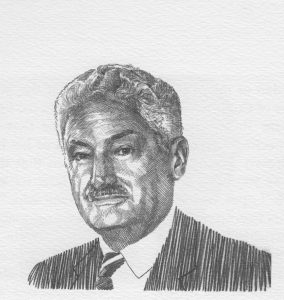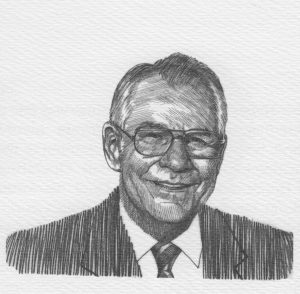Friends say Ray Loper likes to refer to himself as an “old lumberjack.”
And while perhaps that phrase aptly depicts the gentleman’s career roots, it belies his tremendous ensuing success in the fields of the lumber industry and in philanthropy.
Ray E. Loper was born May 20, 1904, in Meehan Junction, Mississippi – in Scott County, near the more familiar and bigger city of Kosciusko. His parents were Robert Emmett Loper and Nora Bell McEwen; at age twenty Ray went to work checking log tallies for his father, then a logging superintendent for the W.P. Brown & Son Lumber Company in Zama, Mississippi. An article he wrote for the company newspaper, “Cutting the Cost,” indicates that even as a young payroll clerk Ray understood what it would take to get ahead in business. “The men who are handling lumber could save quite a bit if they would stop and pick up a board instead of running over it or lay it to one side of the tram till the pick-up crew could get around and get it,” he wrote. “It doesn’t matter if it is nothing but a 1 x 4 x 4 feet No. 3 with bark on one side. Save it! We can get something out of it.”
By the time that Zama plant closed, in 1932, young Ray was plant manager. As one of his last responsibilities in that position, he very profitably liquidated the Zama inventory and equipment, prompting company CEO James Graham Brown to ask him to become plant manager at a sawmill the corporation had just purchased in Falliston, Alabama.
After a few years there, in 1935 Ray Loper moved to Fayette, Alabama, headquarters for Mr. Brown’s southern operations, and assumed the responsibility of supervising the operations of all wood products plan, owned by Brown Alabama, Georgia, and Florida. A letter he wrote to a friend many years later captured his mood at the time: “I felt this was a tremendous responsibility at my age,” wrote. “I talked to my father and brother, Leo Loper, and expressed them how much of a responsibility I felt this was and asked them to look after getting the timber and lumber to the plants with as few mistakes as possible and I would do my best to look after plant production … It is my opinion that my brother and my father did a better job looking after their responsibilities than I did.”
His actions and subsequent progress, however, told a much different story. For nineteen years Ray would make Fayette his home base, traveling to various operations during the week and spending his weekends in the office with the ace books. By then some of the operations sites, including ones in Tuscaloosa, Alabama, and Fayette, bore his name. During this time he would purchase timber, mineral rights, and land until W.P. Brown & Son owned approximately 125,000 acres of timberland. In one of the areas where Ray Loper had made a substantial land purchase, Escambia County, Alabama, oil was discovered in 1951 – and the company profited with some twelve wells.
In 1954 Ray moved the base for southern operations to Bay Minette, Alabama where he had negotiated the purchase of a sawmill, pole peeling plant, and several large tracts of timber. Over the years he guided the Brown organization as it became a very important part of that small town and the area surrounding it, and in 1975 Ray Loper was honored as Man of the Year by the Bay Minette Chamber of Commerce.
In 1969, James Graham Brown passed away. His will left very specific instructions: The James Graham Brown Foundation would be incorporated as successor to all his holdings. And Ray E. Loper would be named president and chief executive officer of that $100 million charitable foundation. In addition to the prestigious Foundation positions, Ray was also named a trustee of that body, and selected to head the Brown operating companies, as well. It is worth noting that this concern at the time included the largest estate in Kentucky, lumber mills, three creosote traveling companies, the Mobile & Gulf Railroad (which served as a common courier), vast real estate holdings, oil wells, three hotels – one which was the famed Brown Hotel in Louisville, Kentucky – and 26,000 shares in Churchill Downs.
Ray Bobo, former vice president, and general manager of the operating companies of the J. Graham Brown Foundation remembers Ray Loper in his then-new position. “Mr. Loper continued to work tirelessly and was a pivotal leader for the company, demonstrating his skills in marketing and the sale of lumber, pressure-treated utility poles, and other southern pine products to many states in the South, East, Midwest and the northern United States, as well as exporting timber products to many foreign countries,” Mr. Bobo said. “He has a mastermind, yet maintained a genuine compassion for his employees.”
He also truly cared for and about his neighbors, as is evidenced by a story Dr. Thomas J. Davidson III of Gulf Shores, Alabama, tells. The physician was a young neighbor of Ray’s in Bay Minette in the 1970s, and the lumber executive found out the man was about to enter medical school with no financial assistance, something that would be difficult for his family. Ray Loper ensured that the Brown Foundation provided Dr. Davidson with support from 1977-1981 while he studied at the University of Alabama at Birmingham, asking in return only that the youth return to his Baldwin County home to set up shop.
“To me that says that Ray Loper, even with all of his business success, has never forgotten that the most important thing in life is how we touch those around us,” Dr. Davidson said. “He set quite an example for an impressionable young man.”
In his role as president and chief executive officer of the foundation, Ray Loper would also establish with others his well-deserved reputation as a wise and caring benefactor, along the way guiding the organization’s growth to some $200 million. Some of the organizations with which he has been personally associated over the years include the United Way, Special Olympics, the Jemison House Foundation and the Tuscaloosa Preservation Society, North Baldwin Hospital, and First United Methodist Church in Tuscaloosa. In 1988 The University of Alabama received $1 million from the James Graham Brown Foundation to establish the Ray E. Loper Endowed Chair of Geology to honor Mr. Loper as a leader in the forest products industry.
Ray Loper is in his 90s now but keeps a home and office in Bay Minette, and a home in Tuscaloosa, where he is well known because of his business and civic activities through the years – particularly his avid support of scholarships at The University of Alabama through his support of the football team. Until 1996 he also had an office in Louisville, Kentucky, which required his attention for bimonthly administrative meetings and duties. He is married to Mary Frances Bird and has three children, son Graham Brown Loper, who is now vice president of the James Graham Brown Foundation, and daughters Cynthia L. Kelly and Connie M. Chambers.
“He is a giant,” said Ray Bobo of his longtime friend and associate, “not only in his working career, but in his care for others and his genuine interest in the well-being of those he lived with, worked with, and enjoyed life with.”





